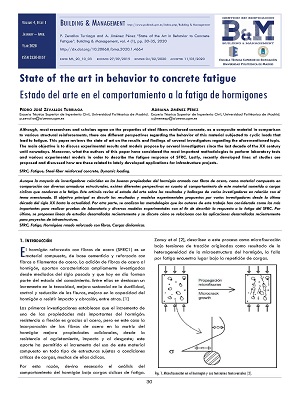
State of the art in behavior to concrete fatigue = Estado del arte en el comportamiento a la fatiga de hormigones
DOI: https://doi.org/10.20868/bma.2020.1.4664
Texto completo:
PDFResumen
Abstract
Although, most researchers and scholars agree on the properties of steel fibers reinforced concrete, as a composite material in comparison to various structural reinforcements, there are different perspectives regarding the behavior of this material subjected to cyclic loads that lead to fatigue. This paper reviews the state of art on the results and findings of several investigators regarding the aforementioned topic. The main objective is to discuss experimental results and models propose by several investigators since the last decade of the XX century until nowadays. Moreover, what the authors of this paper have considered the most important methodologies to perform laboratory tests and various experimental models in order to describe the fatigue response of SFRC. Lastly, recently developed lines of studies are proposed and discussed how are these related to lately developed applications for infrastructure projects.
Resumen
Aunque la mayoría de investigadores coinciden en las buenas propiedades del hormigón armado con fibras de acero, como material compuesto en comparación con diversas armaduras estructurales, existen diferentes perspectivas en cuanto al comportamiento de este material sometido a cargas cíclicas que conducen a la fatiga. Este artículo revisa el estado del arte sobre los resultados y hallazgos de varios investigadores en relación con el tema mencionado. El objetivo principal es discutir los resultados y modelos experimentales propuestos por varios investigadores desde la última década del siglo XX hasta la actualidad. Por otra parte, se analizan las metodologías que los autores de este trabajo han considerado como las más importantes para realizar pruebas de laboratorio y diversos modelos experimentales con el fin de describir la respuesta a la fatiga del SFRC. Por último, se proponen líneas de estudios desarrolladas recientemente y se discute cómo se relacionan con las aplicaciones desarrolladas recientemente para proyectos de infraestructura.
Palabras clave
Referencias
Chang, D. Il, & Chai, W. K. (1995). Flexural fracture and fatigue behavior of steel-fiber-reinforced concrete structures. Nuclear Engineering and Design, 156(1–2), 201–207.
Zanuy, C., Albajar, L., & De la Fuente, P. (2011). El proceso de fatiga del hormigón y su influencia estructural. Materiales de Construcción, 61(303), 385–399.
Lee, M. K., & Barr, B. I. G. (2004). An overview of the fatigue behaviour of plain and fibre reinforced concrete. Cement and Concrete Composites, 26(4), 299–305.
Heeralal, M., Kumar, R., & Rao, Y. V. (2009). Flexural fatigue characteristics of steel fiber reinforced recycled aggregate concrete (SFRRAC). Facta Universitatis - Series: Architecture and Civil Engineering, 7(1), 19–33. https://doi.org/10.2298/FUACE0901019H
Mailhot, T., Bissonnette, B., Saucier, F., & Pigeon, M. (2001). Flexural fatigue behavior of steel fibre reinforced concrete before and after cracking. Materials and Structures, 34(6), 351–359.
Irías, A. (2013). Refuerzo de elementos estructurales con hormigones con fibra o solo fibras.
Germano, F., & Plizzari, G. A. (2012, September). Fatigue behavior of SFRC under bending. In Proceedings of the Eighth RILEM Intnl. Symp. on Fibre Reinforced Concrete: challenges and opportunities,(BEFIB 2012) (pp. 19-21).
Soroushian, P., & Bayasi, Z. (1991). Fiber type effects on the performance of steel fiber reinforced concrete. Materials Journal, 88(2), 129-134.
Lok, T. S., & Pei, J. S. (1998). Flexural behavior of steel fiber reinforced concrete. Journal of Materials in Civil Engineering, 10(2), 86-97.
Chandrashekhar, A., Ravi Shankar, A. U., & Girish, M. G. (2010). Fatigue behaviour of steel fibre reinforced concrete (sfrc) with fly ash. Highway Research Journal, 3(1), 1-28.
Tang, X., An, X., & Maekawa, K. (2014). Behavioral simulation model for sfrc and application to flexural fatigue in tension. Journal of Advanced Concrete Technology, 12(10), 352-362.
Zhang, X., Ruiz, G., & Elazim, A. M. A. (2015). Loading rate effect on crack velocities in steel fiberreinforced concrete. International Journal of Impact Engineering, 76, 60-66.
Germano, F., Tiberti, G., & Plizzari, G. (2016). Post-peak fatigue performance of steel fiber reinforced concrete under flexure. Materials and Structures, 49(10), 4229-4245.
Tarifa, M., Ruiz, G., Poveda, E., Zhang, X., Vicente, M. A., & González, D. C. (2018). Effect of uncertainty on load position in the fatigue life of steel-fiber reinforced concrete under compression. Materials and Structures, 51(1), 31.
Ríos, J. D., Cifuentes, H., Yu, R. C., & Ruiz, G. (2017). Probabilistic flexural fatigue in plain and fiber-reinforced concrete. Materials, 10(7), 767.
Kaur, G., Singh, S. P., & Kaushik, S. K. (2015). Mean and design fatigue lives of SFRC containing cement-based materials. Magazine of Concrete Research, 68(7), 325-338.
Poveda, E., Ruiz, G., Cifuentes, H., Rena, C. Y., & Zhang, X. (2017). Influence of the fiber content on the compressive low-cycle fatigue behavior of self-compacting SFRC. International Journal of Fatigue, 101, 9-17.
Murali, G., Celestina, J. A. S., Subhashini, N., & Vigneshwari, M. (2017, July). Analysis of Flexural Fatigue Strength of Self Compacting Fibre Reinforced Concrete Beams. In IOP Conference Series: Earth and Environmental Science (Vol. 80, No. 1, p. 012023). IOP Publishing.
Enlaces refback
- No hay ningún enlace refback.
Copyright (c) 2021 Autor / BY-NC-ND

Este obra está bajo una licencia de Creative Commons Reconocimiento-NoComercial-SinObraDerivada 4.0 Internacional.










